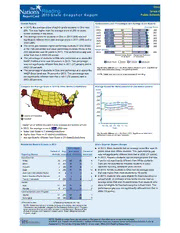
ERIC ED545007: The Nation's Report Card Reading 2013 State Snapshot Report. Ohio. Grade 8, Public Schools PDF
Preview ERIC ED545007: The Nation's Report Card Reading 2013 State Snapshot Report. Ohio. Grade 8, Public Schools
Ohio Reading Grade 8 2013 State Snapshot Report Public Schools Overall Results Achievement-Level Percentages and Average Score Results (cid:132) In 2013, the average score of eighth-grade students in Ohio was 269. This was higher than the average score of 266 for public school students in the nation. (cid:132) The average score for students in Ohio in 2013 (269) was not significantly different from their average score in 2011 (268) and in 2002 (268). (cid:132) The score gap between higher performing students in Ohio (those at the 75th percentile) and lower performing students (those at the 25th percentile) was 46 points in 2013. This performance gap was wider than that in 2002 (39 points). (cid:132) The percentage of students in Ohio who performed at or above the NAEP Proficient level was 39 percent in 2013. This percentage was not significantly different from that in 2011 (37 percent) and in 2002 (35 percent). * Significantly different (p < .05) from state's results in 2013. Significance (cid:132) The percentage of students in Ohio who performed at or above the tests were performed using unrounded numbers. NAEP Basic level was 79 percent in 2013. This percentage was NOTE:Detail may not sum to totals because of rounding. not significantly different from that in 2011 (79 percent) and in 2002 (82 percent). Compare the Average Score in 2013 to Other States/Jurisdictions Average Scores for State/Jurisdiction and Nation (public) ¹Department of Defense Education Activity (overseas and domestic schools). In 2013, the average score in Ohio (269) was (cid:132) lower than those in 7 states/jurisdictions * Significantly different (p < .05) from 2013. Significance tests were (cid:132) higher than those in 21 states/jurisdictions performed using unrounded numbers. (cid:132) not significantly different from those in 23 states/jurisdictions Results for Student Groups in 2013 Score Gaps for Student Groups Percentages (cid:132) In 2013, Black students had an average score that was 26 Percent of Avg. at or above Percent at points lower than White students. This performance gap Reporting Groups students scoreBasic Proficient Advanced was not significantly different from that in 2002 (27 points). Race/Ethnicity (cid:132) In 2013, Hispanic students had an average score that was White 76 273 82 43 6 7 points not significantly different from White students. Black 15 247 58 16 1 Data are not reported for Hispanic students in 2002, Hispanic 3 266 75 34 3 because reporting standards were not met. Asian 2 289 91 61 14 (cid:132) In 2013, female students in Ohio had an average score American Indian/Alaska Native # ‡ ‡ ‡ ‡ that was higher than male students by 10 points. Native Hawaiian/Pacific Islander # ‡ ‡ ‡ ‡ (cid:132) In 2013, students who were eligible for free/reduced-price Two or more races 4 268 81 35 2 school lunch, an indicator of low family income, had an Gender average score that was 25 points lower than students who Male 51 264 75 34 3 were not eligible for free/reduced-price school lunch. This Female 49 274 83 44 6 performance gap was not significantly different from that in National School Lunch Program 2002 (16 points). Eligible 41 254 66 22 1 Not eligible 59 280 88 50 8 # Rounds to zero. ‡ Reporting standards not met. NOTE: Detail may not sum to totals because of rounding, and because the "Information not available" category for the National School Lunch Program, which provides free/reduced-price lunches, is not displayed. Black includes African American and Hispanic includes Latino. Race categories exclude Hispanic origin. NOTE: Statistical comparisons are calculated on the basis of unrounded scale scores or percentages. SOURCE: U.S. Department of Education, Institute of Education Sciences, National Center for Education Statistics, National Assessment of Educational Progress (NAEP), various years, 2002–2013 Reading Assessments.
